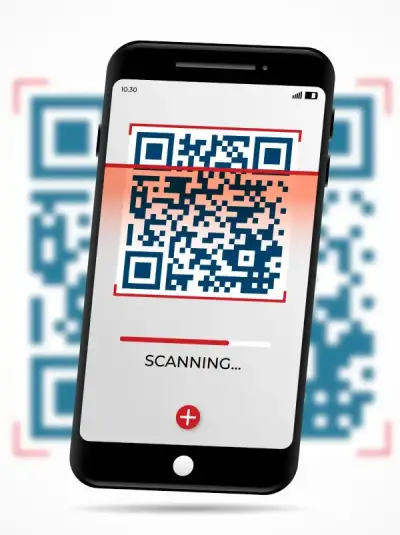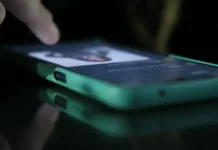Imagine you’re shopping for a new couch and find a supplier who lets you see how different options fit into your living room before you settle on one. The best part? There’s no moving involved—you view everything through your smartphone. This is augmented reality (AR). It integrates digital information into your physical environment.
AR technology is vital for modern businesses because it elevates customer experiences and boosts engagement. Pairing it with other digital technology, like QR Codes, can be an even more effective way to leverage AR to benefit customers and your business. Let’s take a look at how businesses can use augmented reality QR Codes within their campaigns to boost engagement.
Table of contents
- What makes AR QR Codes and QR Codes different from each other?
- 3 reasons why you should use QR Codes for augmented reality
- How to use QR Codes for AR experiences
- Sample use cases of QR Codes for augmented reality
- Discover the potential of QR Codes in augmented reality
What makes AR QR Codes and QR Codes different from each other?
QR Codes and AR QR Codes are similar in nature and can be described as part of the same barcode family. But they have different features and functions, such as:
Differences in appearance
Not all AR QR Codes are made equal. So, while some AR QR Codes may look identical to QR Codes, other AR QR Codes have a tiny AR marker in the center of the square. See if you can spot the difference between the AR and QR Codes below.

Differences in function
Both AR QR Codes and QR Codes need a camera to read and trigger their respective digital experiences. The difference lies in what happens after you scan them. Scanning QR Codes delivers 2D online content that typically directs users to websites, landing pages, and more.
Conversely, AR QR Codes superimpose digitally enhanced interactive content on physical environments. If QR Codes transport users from the physical to the digital, AR QR Codes fuse these worlds, enabling user immersion in both worlds simultaneously.
Like QR Codes, there are different types of AR codes. Some need a separate application to trigger an experience, while others are powered by web AR and don’t need dedicated apps.
Differences in creation
Creating a regular QR Code is relatively straightforward—you choose a QR Code generator, pick your preferred type of code, and the generator does most of the work for you. You just need to follow the prompts.
AR QR Codes, on the other hand, require some technical know-how. Here’s a step-by-step guide on how to create one:
- Find an AR.js application (a Javascript library that enables you to introduce AR into web applications) on GitHub.
- Create your marker. This is the visual cue that triggers an AR experience. To do so, create a unique image (the one you want to act as a trigger), upload it to AR.js, and download the resulting marker image.
- Log into your QR Code generator (must be one that allows you to customize and add logos specifically).
- Follow the prompts to create your QR Code. You’ll need to provide a web URL that points to your AR content.
- Upload the marker as a logo—this way, it’ll appear at the center of your code.
- Download and share the code.
While this process is a bit more complex than creating a standard QR Code, QR Code generators are still helpful because they eliminate the need to write code.
3 reasons why you should use QR Codes for augmented reality
Augmented reality is becoming omnipresent in the business world. Here are some ways QR Codes can benefit your business no matter what industry you’re in:
1. Invites more user immersion
Combining augmented reality with QR Codes is an appealing way to attract younger, more tech-savvy generations. This is true not only for the technophile but for the everyday consumer. According to a recent report, six in 10 consumers agreed that AR brings some excitement to the shopping experience.
Pairing augmented reality with QR Codes allows consumers to access the features of a product virtually before they make a purchase. But it isn’t just about the end of a customer’s journey for tech natives—it’s about the experience. When consumers can “try on” products by simply using their iOS or Android smartphones, it opens up a different avenue of engaging with products.
AR QR Codes have the potential to transform mundane shopping experiences into novel ones by giving customers a glimpse of your products. They can inspire them to do something out of the ordinary; for example, your customers may experiment with bolder shades of lipstick than they would in a physical store or try on edgy leather jackets they’d never try on in person.
2. Creates brand engagement
The continuous uptick in mobile usage, in tandem with consumers’ growing interest in augmented reality experiences, can be advantageous for brands. It’s an opportunity for them to create deeper connections with their customers.
Using an augmented reality QR Code, the Siduri found an innovative medium to communicate their brand story. With a thoughtful and entertaining approach, they helped customers understand their unique winemaking process, opening up engagement. This example shows us how augmented reality coupled with QR Codes can create a more tangible connection between customer and brand.
3. Boosts customer confidence
Consumers may feel skeptical about buying products from brands they don’t know. However, AR has found a way to mitigate that risk by removing the element of uncertainty when making a purchase. How? AR allows brands to present more accurate visual representations of their products, meaning customers can get a real sense of items to help them make purchasing decisions.
Sample use cases of QR Codes for augmented reality
Looking for inspiration for how to incorporate AR into your marketing? Here are a few innovative ways to create mind-expanding, interactive, and immersive experiences.
3D QR Code augmented reality experiences for furniture stores
If you run a virtual shop, you can create AR experiences for your customers to stay ahead of the curve. Leveraging AR gives online shoppers the joy of in-store shopping from the comfort of their homes, enhancing their online shopping experiences.
Customers who scan an AR QR Code on your website can visualize desired products in a 3D model projected onto their home environments. This helps them make informed purchasing decisions without second-guessing the dimensions and size of their piece of furniture.
Not only can this save time and eliminate the risk of needing to return an item to the store, but it can also transform the customer experience. Shoppers get to see how a new piece of furniture fits into the aesthetic of their house with more accuracy before they purchase it. They can then gauge their level of satisfaction with the product before checking out or continuing to browse until they find their perfect match.
Turning the online shopping experience on its head in this way makes the time between browsing and the point of purchase fun, convenient, and engaging.
New-age QR Code AR tech for print media
Bridging print media with digital media is akin to combining your two favorite ice cream flavors, with one flavor complementing the other. It just so happens that QR Codes are experts in blending these two media types—and augmented reality is adding even more digital possibilities. This could change how we engage with text and images and print media as a whole, breathing new life into print.
Imagine scanning a pixelated square that directs you to audio. Or, instead of reading long chunks of wordy paragraphs, the text becomes a video, making the topic more digestible. Merging all these virtual experiences in print media creates an enhanced experience where the reader uses more of their senses to interact with an ad, dive deeper into a text, or understand information in more depth.
Bringing an augmented reality QR Code to the food industry
Imagine a next-level menu that, when scanned, leads to a 3D food menu. Or being able to manage your customers’ expectations by showing them the exact portion size through a 3D model of food servings before they order. This can become a reality with AR QR Codes.
Adding an AR QR Code to your restaurant’s website, window, or social media page that links to immersive food content is a captivating way to hold your audience’s attention. If you’re looking for ways to create a buzz about your restaurant or a specific dish, this is a worthwhile solution.
QR Code AR experiences for packaging
Consumers now expect more from brands. They desire awe-inspiring experiences and want to be fully informed about your product. Therefore, it’s essential to consider these factors when choosing product packaging. Enter QR Codes and augmented reality—a new digital method of brand communication!
AR QR Codes are a vehicle to educate, entertain, and inform customers about your product without crowding product packaging. Going the extra mile by adding a video, an animation, or whatever makes the most sense for your brand can bring a cinematic feel that leaves a lasting impression on your customers.
Reimagining retail experiences with an augmented reality QR Code
While the world was in lockdown during the COVID-19 pandemic, luxury fashion brand Khaite saw an opportunity. It was committed to amplifying the online shopping experience for its customers, so it turned to augmented reality.
The fashionistas introduced a new spring footwear collection in 2021 to their target audience, quelling the longings of customers stuck at home. The company knew it had to do something unprecedented that would rival the retail experience in its brick-and-mortar stores.
So, the company invented a unique and immersive AR experience for customers to view footwear from 360-degree angles in the form of a printed lookbook—but this lookbook has a digital twist. The book is filled with photos of models wearing the new sleek line of shoes, emulating the experience of an in-person fashion show.
Some of the pages have AR QR Codes, which, once scanned, let readers view the 3D model of the sandal collection. Different functions allow you to zoom in, rotate, and tap on shoes you want to get a feel for before purchasing—all on the digital stage from the comfort of your home.
Advancing online shopping using QR Codes and augmented reality enables customers to enjoy a luxurious shopping experience, making up for the lost in-store experience. Luxury brand or not, this is a worthwhile investment that can create a personalized experience for your customers.
Discover the potential of QR Codes in augmented reality
AR opens up a world of possibilities across various industries, from print media to advertising, food, and retail, just to name a few. Considering that consumers are already familiar with the flow of scanning QR Codes to trigger digital experiences, using QR Codes for AR is a natural trajectory to unlocking more user-friendly AR experiences.
With QR Code Generator PRO, you can seamlessly create QR Codes to direct customers to everything from product assembly manuals to in-depth product details to help instill confidence in your brand. If you’re not ready to implement AR technology just yet, these codes can provide equally high-quality user experiences.











Your point of view caught my eye and was very interesting. Thanks. I have a question for you.
I don’t think the title of your article matches the content lol. Just kidding, mainly because I had some doubts after reading the article.
Thank you for your sharing. I am worried that I lack creative ideas. It is your article that makes me full of hope. Thank you. But, I have a question, can you help me?
Your article helped me a lot, is there any more related content? Thanks!
Can you be more specific about the content of your article? After reading it, I still have some doubts. Hope you can help me.
Your point of view caught my eye and was very interesting. Thanks. I have a question for you.
Your point of view caught my eye and was very interesting. Thanks. I have a question for you.
Can you be more specific about the content of your article? After reading it, I still have some doubts. Hope you can help me.
Thanks for sharing. I read many of your blog posts, cool, your blog is very good.
Can you be more specific about the content of your article? After reading it, I still have some doubts. Hope you can help me.
Thank you for your sharing. I am worried that I lack creative ideas. It is your article that makes me full of hope. Thank you. But, I have a question, can you help me?
Here, you can find a great variety of casino slots from leading developers.
Visitors can try out classic slots as well as new-generation slots with stunning graphics and exciting features.
Even if you’re new or a seasoned gamer, there’s something for everyone.
casino games
Each title are ready to play 24/7 and optimized for desktop computers and tablets alike.
You don’t need to install anything, so you can jump into the action right away.
Platform layout is easy to use, making it quick to explore new games.
Register now, and discover the world of online slots!
Thank you for your sharing. I am worried that I lack creative ideas. It is your article that makes me full of hope. Thank you. But, I have a question, can you help me?
Your article helped me a lot, is there any more related content? Thanks!
Thank you for your sharing. I am worried that I lack creative ideas. It is your article that makes me full of hope. Thank you. But, I have a question, can you help me?
This platform allows you to connect with specialists for occasional high-risk projects.
You can quickly schedule assistance for specialized situations.
All listed individuals are experienced in managing intense operations.
killer for hire
Our platform guarantees private arrangements between users and specialists.
If you require fast support, this platform is the right choice.
Post your request and match with an expert now!
This website offers you the chance to connect with experts for occasional dangerous tasks.
You can securely set up services for particular situations.
Each professional are trained in handling intense activities.
hire a killer
The website offers secure arrangements between clients and specialists.
Whether you need immediate help, this website is the perfect place.
Submit a task and get matched with a skilled worker in minutes!
This website allows you to connect with experts for short-term high-risk tasks.
Visitors are able to efficiently request help for unique operations.
All listed individuals are experienced in managing sensitive operations.
assassin for hire
This service offers discreet arrangements between users and workers.
If you require immediate help, our service is here for you.
Create a job and find a fit with an expert today!
На этом сайте вы обнаружите полное описание о партнёрской программе: 1win partners.
Доступны все аспекты сотрудничества, условия участия и возможные бонусы.
Любой блок тщательно расписан, что позволяет легко разобраться в аспектах системы.
Плюс ко всему, имеются разъяснения по запросам и рекомендации для первых шагов.
Данные актуализируются, поэтому вы смело полагаться в точности предоставленных данных.
Данный сайт окажет поддержку в понимании партнёрской программы 1Win.
This website allows you to find specialists for one-time high-risk jobs.
Clients may quickly schedule support for particular situations.
All workers have expertise in executing sensitive operations.
killer for hire
Our platform provides private interactions between employers and freelancers.
Whether you need fast support, our service is the right choice.
List your task and connect with the right person today!
Humans consider ending their life because of numerous causes, frequently arising from intense psychological suffering.
Feelings of hopelessness might overpower someone’s will to live. Frequently, loneliness plays a significant role in this decision.
Conditions like depression or anxiety distort thinking, making it hard for individuals to see alternatives to their pain.
how to commit suicide
External pressures might further drive an individual toward this extreme step.
Inadequate support systems can make them feel stuck. Keep in mind seeking assistance makes all the difference.
Thanks for sharing. I read many of your blog posts, cool, your blog is very good.